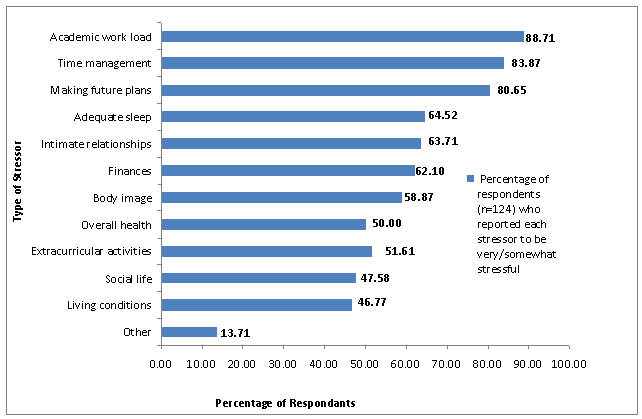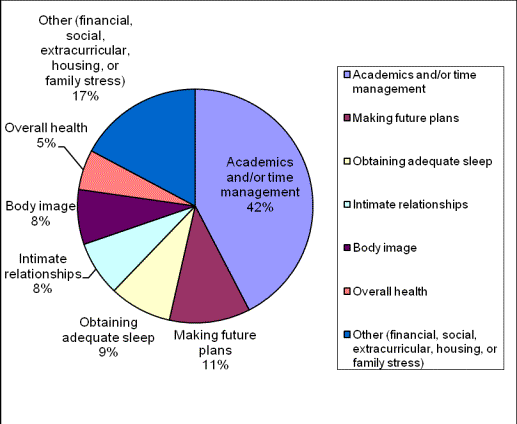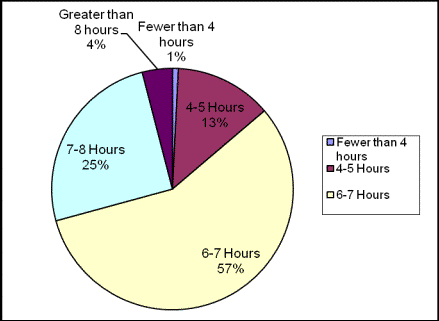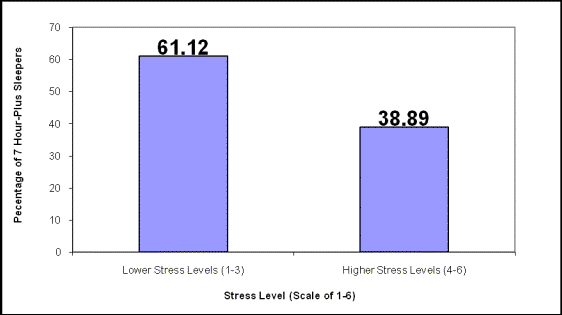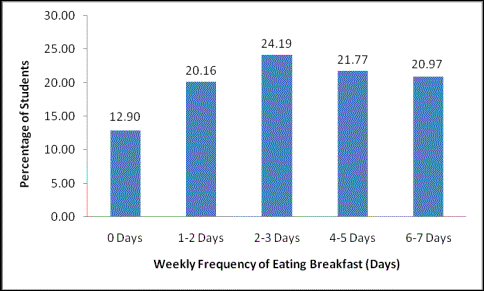Sources and Outlets of Stress among University Students:
Correlations between Stress and Unhealthy Habits
Jacqueline Britz,
Eric Pappas*
James Madison University
Keywords: stress, health, university health, health perception, sleep, nutrition
Abstract
This research into stress assessed the sources and outlets of stress among a group of 124 college freshmen at James Madison University. Results revealed that a high degree and frequency of stress exists among the participants, with over 50 percent of students reporting high levels of stress. The major causes of stress were found to be academic workload and time management. High stress levels among participants correlated with many unhealthy behaviors, including compromised quality of diet and decreased quantity of sleep.
Introduction
Stress permeates almost every aspect of society and has now become a normal experience for most Americans. Although stress was called the “The epidemic of the 80’s” by Time magazine, stress levels in America since then have continued to rise (America’s No.1 Health Problem, 2009). A 2007 national survey conducted by the American Psychological Association (APA) found that one-third of all Americans live with extreme levels of stress and that about half of Americans (48 percent) believed that their stress levels had increased in the five years prior to the study (Stress, 2007). Physical and psychological symptoms of stress were also found to be increasing in participants. According to Russ Newman, APA executive director for professional practice, in reference to the 2007 national survey: “We know that stress is a fact of life and some stress can have a positive impact; however, the high stress levels that many Americans report experiencing can have long-term health consequences, ranging from fatigue to obesity and heart disease” (Stress, 2007).
There are many known negative implications of stressful life circumstances on personal health. Temporary stress can cause elevated blood pressure, headaches, stomachaches, sleeping problems, and chest pains. Stress also has been shown to inhibit the immune system, leading to more colds and sickness in times of stress. Further, chronic stress can severely impact both mental and physical health. It can decrease the likelihood of individuals to practice healthy habits (including eating a nutritious diet, obtaining adequate sleep, avoiding smoking and drinking in excess, and fostering positive relationships). Distress, a form of stress that negatively impacts the body, is associated with many serious and deadly health risks including various cancers, cirrhosis of the liver, heart disease, lung problems, and in some instances, suicide (Chakraburtty, 2005).
A 2004 meta-analytic study, which was based on 30 years of research into the relationship between stress and the human immune system, concluded that as a stressor becomes more chronic, its influence on the body’s ability to fight disease becomes magnified (Segerstrom & Miller, 2004). The European Heart Journal reported that in a study of over 10,000 civil servants in London, there was a 68 percent higher risk of heart disease in stressed employees over unstressed employees (Chandola, Britton, & Brunner, 2008). Consequently, stress has been labeled by The American Institute of Stress, in addition to countless current researchers, as “America’s #1 Health Problem” (2009).
This stress is felt dramatically among university students, and academic pressures can lead to the development of unhealthy habits. This study assessed a group of college students concerning their stress levels, in addition to the sources and outlets of stress. The sample included 124 male and female college freshmen studying in a wide variety of disciplines. Results indicated the major causes of stress among the participant population, in addition to unhealthy behaviors that often correspond to higher stress levels. Consequently, this study revealed that stress can be a significant barrier to maintaining a healthy lifestyle.
Literature Review
Although the majority of discussion about the effect of stress on health has been focused on older populations, younger generations are already demonstrating risks for future health problems associated with stress. Many recent studies have addressed this concern through research into youth stress specifically. A recent study performed by Semel Institute for Neuroscience and Human Behavior at UCLA investigated the likelihood of current stress among youth impacting adult health. Blood samples from the 69 teenage participants revealed that higher levels of stress are associated with higher levels of inflammation, indicating a greater risk for heart disease in adulthood (Wheeler, n.d.). Even more unsettling was that the physiological impacts of these stress levels were already showing. The causes and implications of these stress levels require more investigation, as most previous research conducted on the correlation between high stress levels and health problems has been focused on adulthood. Lack of sufficient research into the effect of stress on younger generations could prompt a failure to prevent even more serious future health risks than currently exhibited by older generations.
Many studies have attempted to determine the major sources of stress among college students. The 1999 Student Stress Survey identified daily struggles, as opposed to major occurrences in life, as accounting for greater stress among students. It also found some of the more prevalent stressors to be changes in sleeping or eating patterns, increased workloads, vacations, and new responsibilities (Ross, Niebling, & Heckart, 1999).
Further studies noted correlations between stress and personal behaviors. Students who were more stressed were found to have lower self-esteem and less awareness of their health (Hudd, Dumlao, & Erdmann-Sager, 2000). There was also a correlation between stress and time management, with increased management skills leading to decreased stress levels (Misra & McKean, 2000). In another study, first-year undergraduate students at a university showed improvement in academic, social, and personal adjustment as stress levels decreased over a ten-week period (Friedlander, Shupak, & Cribbie, 2007).
Previous researchers have investigated the effect of particular stressors on specific healthy behaviors. Healthy behaviors can be defined as those actions taken to avoid disease and illness and to maintain or prompt good health (Farlex, 2009). Increased stress has been identified as a predictor of unhealthy behaviors, such as smoking, drinking, eating poorly, infrequent exercising, and obtaining inadequate amounts of sleep (Von Ah, Ebert, & Ngamvitroj, 2004). Kandiah, Yale, & Jones (2006), when researching the eating habits of female undergraduate students, found that 81 percent of students’ appetites changed when they were stressed. Only 33 percent of all the students reported eating healthily when stressed, while the rest ate more sweet and fast foods.
Ginsberg (2006) found a similarly unhealthy relationship between stress and sleeping habits, reported in the study “Academic Worry as a Predictor of Sleep Disturbance in College Students.” In this study, students were assessed on the Academic Stress Scale, the Sleep Disturbance Ascribed to Worry Scale, and on usual lengths of sleep periods. The Academic Stress Scale was developed by the degree of participant stress in response to physical, psychological, and psychosocial factors, while the Sleep Disturbance Ascribed to Worry Scale is an efficient method of identifying the extent of sleep disturbance based on participant rankings of five items pertaining to worry and sleeping patterns. Based on these scales, the participants in the study exhibited a negative relationship between academic stress and length of sleep (Ginsberg, 2006). Long term, these unhealthy habits can be extremely dangerous.
Despite the above literature on stress and its correlating health risks, little work has been focused on determining how stressful students find sources of stress to be and how all these sources of stress correlate to a variety of unhealthy habits. Hudd et al. (2000) found “more stressed” students to be more likely to exercise infrequently and to eat junk food, while “less stressed” students were more likely to have healthy habits, such as eating nutritious foods. More research is required in order to develop adequate programs to decrease stress levels on college campuses. This study was designed to address this issue.
JMU Stress Study
The present study built upon the previously noted literature in order to better determine the correlation between stress and health. Although previous studies focused on the effect of a particular stressor on a specific component of health, this study focused on broader trends. The specific purpose of the study was first to determine the greatest causes of stress for JMU freshmen and to discover how stressful these sources were. Next, the connection between these sources of stress and numerous unhealthy behaviors (such as compromised sleep quality and poor nutrition) was assessed.
It was hypothesized that academic workload would be a common source of stress for students of all ages although college freshman would also find living conditions to be very stressful. It was also expected that bad moods and anxiety would be common results of stress. As for general health, it was anticipated that sleep time, personal time, smoking, and the number of days breakfast was consumed would be low. In contrast, it was expected that JMU students would record a greater frequency of working out, eating healthy, and partying. The actual results of the relationship between stressors and unhealthy habits identified pertinent trends that can now be used to guide future studies and modify current university programs so that students have better access to the knowledge and resources necessary to reduce excessive stress levels and promote healthy outlets.
Methodology
Sample
The sample for this study consisted of 124 undergraduate freshman students (n= 58m, 66f) at James Madison University. The students were enrolled in a general education course and were approximately the same age (18). The group included students who were studying in a wide variety of academic disciplines, achieved a normal range of grade point averages, and displayed a variety of extracurricular interests. The survey was entirely voluntary; however, it was completed by all students in the class.Variables
The questions in the survey were used to gather data on the following topics: a) demographic information, b) sources of stress, c) the magnitude of stress, and d) outlets for this stress, including unhealthy habits.Procedure
The survey was given to students during class, and a sufficient amount of time was allotted to complete it. It was administered half way through the 2008 fall semester, when students’ workloads tend to be average. The initial questions were designed to gather demographic data on the students, including sex, academic year, age, and grade point average (GPA). Questions then focused on determining how stressed students considered themselves to be: students were asked first to rate their average overall level of stress, in addition to how frequently they found themselves to be stressed. One section of the survey required participants to rank the stress level of certain factors including academic workload, finances, making future plans, living conditions, social life, intimate relationships, body image, time management, extracurricular activities, adequate sleep, and overall health.The latter part of the study focused first on how students thought they respond to stress. It inquired about the participant’s degree of involvement in a variety of unhealthy and healthy behaviors (including sleeping and resting, exercising, drinking, smoking, and nutritious eating). A great deal of effort was focused on making sure questions were asked in a manner which was both concise and not leading. In addition, limitations on objectivity were considered. Although ranking stress sources and magnitude, in addition to personal health, is subjective, students were presented scales to rank each factor (from level 1 to 6, with 6 being the highest, in most cases). In addition, space was provided to specify extenuating circumstances that could skew results.
Results
Out of the 124 participants in the study, 65 students (52.4 percent) ranked (on a scale of 1 to 6, with 6 being the highest) their perceived stress levels to be greater than a 3. The ranking of stress frequency was approximately equal, with 63 students (50.8 percent) noting that they are often or always stressed. Figure 1 shows the greatest causes of stress reported by students, and the percentage of participants who ranked each as “somewhat” or “very” stressful on a scale of 1 to 6 (with 6 being the most stressful).
Factors Ranked Somewhat or Very Stressful
Figure 1: Percentage of students who ranked each source as being somewhat or very stressful (i.e. respondents marking stressor as a 3 or greater than 3 on a scale of 1 to 6). Q3. Rate the following on how stressful each factor is in your life (not stressful, somewhat stressful, or very stressful).Academic workload and time management were ranked by the most students as being somewhat or very stressful. These factors were followed, in decreasing prevalence, by the following: making future plans, obtaining adequate sleep, intimate relationships, finances, body image, overall health, extracurricular activities, social life, living conditions, and other. Figure 2 displays the stressors students considered to be the “most stressful.” Most students had several stressors that were equally stressful and listed them together.
The Most Stressful Factors for Students
Figure 2: Percentage of students who marked each “stressor” as being one of the factors that causes the most stress in their lives. Q4. Please write which item(s) listed in the above question cause(s) the most stress in your daily life.Academics and time management were often mentioned together as factors causing stress and were marked by 42 percent of students as being one of the most stressful factors. Following, similar to the results of the previous question are the following: making future plans, obtaining adequate sleep, intimate relationships and body image, and overall health.
The overall negative influence of these stressors, as perceived by the students, are varied and include all the options presented in the survey, such as increased anxiety, conflict in relationships, changes in grades, decreased sleep, impaired health, increased partying, weight fluctuation, and mood changes. As mentioned earlier, out of the 124 participants, approximately 50 percent reported experiencing high levels of stress. In addition, approximately 50 percent of the 124 participants reported experiencing feelings of stress at high frequencies. With such a high degree of stress present among the entire participant group, trends between “more stressed” students and “less stressed” students are not easily distinguishable. The results do distinguish high percentages of students who are stressed and high percentages of students who exhibit unhealthy behaviors.
In terms of unhealthy behaviors, the strongest correlations to high stress levels were found in relation to sleeping patterns and eating habits. Students were specifically asked about the typical amount of sleep. Data regarding sleep prevalence among the students, shown in Figure 3, reflect a range of sleep habits. A more focused look at the correlation between sleep habits and stress levels is shown in Figure 4.Hours of Sleep
Figure 3: Percentage of students obtaining each range of sleep lengths, with the majority obtaining between 6 and 7 hours of sleep.Stress Levels of Students Who Sleep Over 7 Hours
Figure 4: Percentage of the 36 students who sleep over 7 hours who have lower stress levels (ranking levels 1 to 3 on a 6 point scale) and higher levels (ranking between levels 4 and 6).The majority of students (57 percent) reported sleeping 6 to 7 hours per night. Only 29 percent reported sleeping longer than that amount, while 14 percent of students obtain fewer hours of sleep. In terms of the correlation between stress and sleep, out of the 63 students who have higher levels of stress (ranking a 4, 5 or 6 on a scale of 1 to 6), 77.8 percent obtain fewer than 7 hours of sleep per night. Out of the students who reported lower stress levels, a slightly lower percentage, 63.9 percent, obtain fewer than 7 hours of sleep. Out of the 36 students who sleep over 7 hours each night, 61.1 percent reported lower levels of stress. This stress does not only correlate with sleep deprivation but also with low levels of general relaxing time. Out of the 124 participants, about 1 in every 6 individuals obtains fewer than 30 minutes of relaxing or personal time per day.
Another important health factor considered was nutrition. The two questions about nutrition sought to obtain more information about students’ perception of their diet, in addition to their actual nutritional behaviors. Approximately 70 percent of the students involved in the study perceived themselves as having fairly or very healthy diets. In terms of specific dietary behaviors, students were asked a question about their tendency to eat breakfast each morning, the results of which are displayed in Figure 5.
Number of Students Eating Breakfast per Week
Figure 5: The frequency of eating breakfast per week for the surveyed students.Ironically, approximately 80 percent of students do not eat breakfast every day, 57 percent eat breakfast fewer than 4 or 5 times per week, and 12.9 percent report never eating breakfast. Most students did not mention what they considered to be breakfast; however, some students specified eating a bagel and cream cheese, or a Pop-Tart, for breakfast.
Discussion
Robert Sapolsky, an American neuroendocrinologist who has performed extensive research on stress, stated: “Stress-related disease emerges, predominantly, out of the fact that we so often activate a physiological system that has evolved for responding to acute physical emergencies, but we turn it on for months on end” (Sapolsky, 1998). Exposure to chronic stress will have long-lasting implications on health. Unfortunately, as the results of this study confirm, college students are not immune to these excessive amounts of stress or the troubling health effects that may already be showing.
As was hypothesized, most participants reported academic workload to cause great amounts of stress in everyday life. Stress from living conditions was much less prevalent than expected, but instead, time management was inextricably linked with academic workload as being the two greatest sources of stress. In addition, as anticipated, high percentages of the students exhibited unhealthy behaviors; however, not all behaviors correlated directly with increased stress magnitude or frequency.
The high levels of stress reported by the survey participants could make it more difficult to discriminate particular trends, as the results do not show a great deviation in healthy behaviors between those who are often stressed and those who are always stressed. Nonetheless, the results of this study provide two particularly important insights that require immediate attention: the significant number of JMU study participants who are immensely and frequently stressed, in addition to the prevalence of unhealthy behaviors displayed by these students. Certain unhealthy behaviors, such as smoking, drinking, and partaking in low amounts of exercise, do not seem to correspond directly with stress levels. Further efforts to improve health on college campuses should address factors that promote these behaviors.
The two most significant unhealthy behaviors associated with the stressed participants in this study are sleeping and eating patterns. The self-perceived effects of student stress are varied and include increased anxiety, conflict in relationships, apparent negative influences on grades, decreased sleep, impaired health, increased partying, weight fluctuation, and mood changes. Many students specified that their health was a source of stress for them, and about 6 percent of all students ranked overall health to be one of the greatest causes of personal stress. Although health is clearly a concern for many of the participants in this study, it is not known whether these participants directly see a correlation between the stress they experience and the unhealthy habits they exhibit. Only a few students directly addressed this connection in the space for comments provided at the end of the survey.
As mentioned, one healthy behavior of concern is eating nutritiously. The Food Standards Agency recommends eating a healthy breakfast every day for a healthy diet (FSA, 2009). Although breakfast itself is extremely important for health, it is also a predictor of an overall healthy diet. According to a recent study performed by researchers at the University of Minnesota School of Public Health, teenagers who regularly ate breakfast were more likely to have healthy diets than those who did not eat breakfast (Timlin, Pereira, & Story, 2008). Although about 70 percent of students in this JMU study reported having fairly or very healthy diets, almost 80 percent of students did not eat breakfast every day. Out of that 80 percent, 16 percent reported never eating breakfast. One factor to consider in educational programming is students’ perception of health and what constitutes a healthy meal. The Food Standards Agency emphasized the importance of a balanced breakfast (FSA, 2009), but many students reported regularly eating Pop-Tarts or similarly sugary foods for breakfast.
In addition, the resting patterns of students provoked particular interest. The National Sleep Foundation recommended 7 to 9 hours of sleep per night (NSF, 2009). Many researchers confirm these recommendations; scientific studies have suggested even longer periods of rest (Coren, 2005), yet only about 30 percent of the student participants reported sleeping within that range. With approximately 57 percent of participants obtaining 6 and 7 hours of sleep, nearly 70 percent of students sleep fewer than the recommended number of hours. Further, about 1 out of every 7 students (14 percent) had extremely low amounts of sleep, about 4 to 5 hours, while 1 percent slept even fewer than 4 hours.
On one hand, every individual requires a unique amount of rest to function optimally. Although 7 to 9 hours is the recommended amount of sleep, others many require more or less than this amount. Further, it is encouraging that while some students get fewer than 5 hours of sleep per night, the majority of students (57 percent) did not deviate far from the recommended range of 7 to 9 hours of sleep per night (Figure 4). On the other hand, 9 percent of students reported one of the greatest causes of stress to be obtaining adequate amounts of sleep, and sleep was a concern for even many of the students who did not list it as the greatest stressor. This is an issue that affects both students who are stressed and those who are not stressed although the population of less stressed students made up a greater percentage of those students obtaining larger amounts of sleep.
According to a recent Carnegie Mellon University study, individuals who obtained fewer than 7 hours of sleep per night were about three times as likely to catch a cold than individuals getting 8 or more hours of sleep (Cohen, Doyle, & Alper, 2009). Researchers have found that the human immune system is most proficient during times of rest; therefore, chronic sleep deprivation puts the body at risk for countless medical problems (Coren, 2005). This sleep deprivation, and other student behaviors that correlate with high levels of stress, can therefore have serious implications for current and long-term health. This insight, in addition to information about the causes of stress, can be utilized to address college-related stress directly through university programs and further investigations.
Limitations and Conclusions
There are a few limitations to be considered when making conclusions from this study, including the demographics of the participants. Although a participant group consisting entirely of freshman students is useful in terms of comparison, it lends to difficulty in making accurate assumptions about all college students in general (both at and beyond James Madison University). Further, the limitation of subjectivity should be taken into account. Perception of stress levels can vary among individuals and throughout times of the year. Further, many students may not display an impartial account of their own health. This variable of subjectivity, however, was limited by the large scales provided by the survey to rank stress levels and health, in addition to the space provided for students to specify extenuating circumstances that could bias results.
Another limitation to be considered is the distinction between correlation and causation. Although stress correlates with many characteristics of health, this study does not establish that increased stress directly compromises health or increases unhealthy tendencies. It does, however, demonstrate correlation, which is important for the development of specific programs to decrease stress and improve health among college students.
Regardless of limitations, it still remains that more than 50 percent of students reported significant frequencies of being stressed. At the same time, more than 50 percent of students also rate themselves as having somewhat or very high amounts of stress. These numbers certainly draw attention to the extent of stress levels among students. The unhealthy behaviors that correlate with these high levels of stress, namely sleep deprivation and unhealthy diets, are equally of importance. Unhealthy patterns were further confirmed indirectly through other questions. For example, asking about participant consumption of breakfast indirectly provided information about the quality of eating habits, which provided a more objective dietary account than the participants’ subjective interpretation of personal health. The results of this study indicate the need for further action to improve the mental and physical health of students on campus.
Recommendations and Further Studies
It is important to spread knowledge about the prevalence of stress among university students. Gaining a greater awareness is the first step in alleviating the sources and effects of stress. Next, the results of this study and other studies can be used to focus university programs so they can appropriately address the major sources and outlets of student stress. Some sources of stress are unavoidable, such as financial or family pressures; however, the most prevalent forms of stress, academic workload and time management, could be decreased through time management workshops. Although it may not be possible to decrease the academic workloads of modern day students, it is important for universities to develop programs to help students deal with this stress. Actions could include the creation of adequate counseling resources and clinical advice. The development of university programs should be focused on how to provide the knowledge and resources for students to healthfully cope with stress and to therefore reduce the potential negative implications of stress on health.
Further studies are necessary to improve knowledge about the specific factors students reported as sources and outlets of stress. This study exposed practical information pertinent to the creation and implementation of programs and also set the foundation for further research. It is essential to perform a similar study with college students of all ages, to see if the trends reported in this population transcend all college years. Another useful study would be to further investigate the contrast between students’ actual health and perceived health. Knowing this correlation is imperative to gaining awareness about the influence of stress among college students.
This study, while focusing specifically on freshmen at James Madison University, provides information that is pertinent to other college campuses and to researchers in the field. Future studies should be performed to gather information about how student programs can be developed to alleviate or cope with the specific causes or effects of stress. The juxtaposition of increased knowledge about stress and health of college students, in addition to the efficacy of student programs, will provide powerful insights into how to combat the effects of stress on younger generations.
References
America's No. 1 Health Problem. (no date). American Institute of Stress. http://www.stress.org/americas.htm
Chakraburtty, A. (2005). “Stress, Anxiety, and Depression: How They Affect Your Health.” The Cleveland Clinic website: http://www.webmd.com/depression/stress-anxiety-depression
Chandola, T., Britton, A., & Brunner, E. (2007). Work stress and coronary heart disease: what are the mechanisms? European Heart Journal, 29(5), 640-648.
Cohen, S., Doyle, W., & Alper, C. (2009). Sleep Habits and Susceptibility to the Common Cold. Archives of Internal Medicine , 169(1), 62-67.
Coren, S. (2005). The real cost of sleep debt: inadequate sleep due to extended workdays, overtime, and shift work is increasing health and safety risks for employees and may expose them or their employers to legal liabilities. The Journal of Employee Assistance, 35(4), 16.
Farlex (2008). Health Behavior. The Free Dictionary by Farlex. Mosby's Dental Dictionary website: http://medical-dictionary.thefreedictionary.com/Healthful+behavior
Friedlander, L., Shupak, N., & Cribbie, R. (2007). Social Support, Self-Esteem, and Stress as Predictors of Adjustment to University Among First-Year Undergraduates. Journal of College Student Development, 48(3), 259-274.
FSA (2009). 8 Tips for Eating Well. Food Standards Agency (healthy diet). http://www.eatwell.gov.uk/healthydiet/eighttipssection/8tips/
Ginsberg, J. (2006). Academic Worry as a Predictor of Sleep Disturbance in College Students. The Journal of Young Investigators,14(4).
Hudd, S., Dumlao, J., & Erdmann-Sager, D. (2000). Stress At College: Effects On Health Habits, Health Status And Self-Esteem. College Student Journal, 34(2), 217-227.
Kandiah, J., Yake, M., & Jones, J. (2006). Stress influences appetite and comfort food preferences in college women. Nutrition Research, 26(3), 118-123.
Misra, R., & McKean, M. (2001). College Students’ Academic Stress and Its Relation to Their Anxiety, Time Management, and Leisure Satisfaction. American Journal of Health Studies, 16(1), 41-51.
NSF (2009). How Much Sleep Do We Really Need? National Sleep Foundation (NSF). http://www.sleepfoundation.org/article/how-sleep-works/how-much-sleep-do-we-really-need
Ross, S., Niebling, B., & Heckart, T. (1999). Sources Of Stress Among College Students. College Student Journal, 32(2), 312-318.
Sapolsky, R. M. (1998). Why Zebras Don’t Get Ulcers: An Updated Guide to Stress, Stress-related Disease, and Coping. New York: Freeman.
Segerstrom, S., & Miller, G. (2004). Psychological Stress and the Human Immune System: A Meta-Analytic Study of 30 Years of Inquiry. Psychological Bulletin , 130(4), 601-630.
Stress a Major Health Problem in The U.S., Warns APA. (2007). American Psychological Association (press release), October 24, 2007.
Timlin, M., Pereira, M., & Story, M. (2008). Breakfast Eating and Weight Change in a 5-Year Prospective Analysis of Adolescents: Project EAT (Eating Among Teens). Pediatrics, 121(3).
Von Ah, D., Ebert, S., & Ngamvitroj, A. (2004). Predictors of health behaviors in college students. Journal of Advanced Nursing , 48(D), 463 - 474.
Wheeler, M. (no date). Teenage stress has implications for adult health. In UCLA Newsroom. http://newsroom.ucla.edu/portal/ucla/teen-angst-has-implications-for-84277.aspx
|
